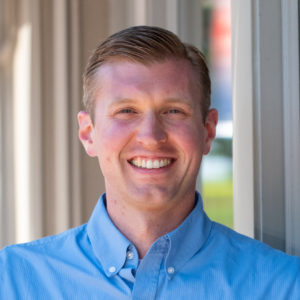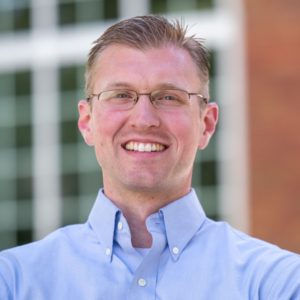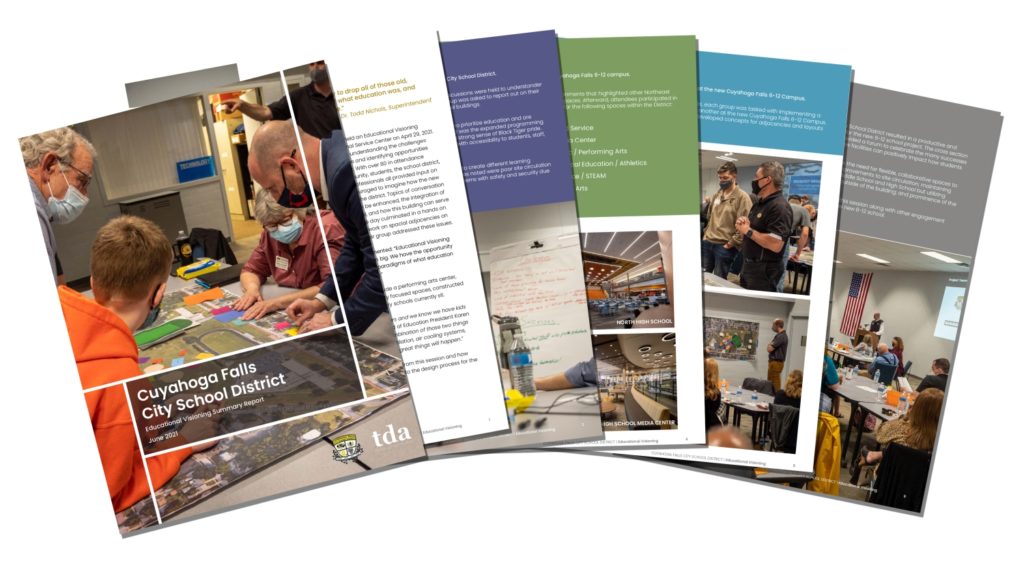Educational Visioning for Cuyahoga Falls, New 6-12 Facility
On April 29th 2021, ThenDesign Architecture held an “Educational Visioning” session at the Summit Educational Service Center in Cuyahoga Falls to begin designing for the future of the district’s new 6-12 campus. This day-long event focused on understanding the current challenges with the existing facilities and identifying opportunities the new building will bring. With over 80 in attendance, members of the community, students, administrators, along with architecture and construction professionals provided input on the project. Attendees were encouraged to imagine how the new facility will improve education across the district. Topics of conversation included how core academics will be enhanced, the integration of the middle and high school, and how the building can serve as “the hub of the community” in Cuyahoga Falls.
Those who attended brainstormed ideas, defined priorities, and presented educational goals that will be used during the development of the new building.
See the inside view of the Educational Visioning Session.
Educational Visioning, Designing for the Future
Superintendent Todd Nichols commented: “Educational Visioning really sets the stage for us to dream big. We have the opportunity to drop all of those old, antiquated paradigms of what education was, and think about what it can be. Then we will design a building around that vision. That’s the proper process and what has led us up to this point.”
The construction site is located where the Bolich and Newberry schools currently sit. This new 370,000 sf building will include a performing arts center, sports stadium and community focused spaces.
The new school will enable new educational programs and opportunities to better serve middle and high school students in the district.
“We know that we have good teachers, and we know we have kids who love to learn,” commented Board of Education President Karen Schofield, “we know that with the combination of those two things in a new facility with appropriate ventilation, air cooling systems, natural light and flexible spaces, only great things will happen.”
Activities Designed to Set Educational Goals
Educational Visioning Sessions are built around the idea that through collaboration, discussion and exploration, attendees can set educational and architectural goals that can be achieved in the new facility. Attendees are assembled into small groups that include students, educators, parents, community members and administrators. They collaborate on three main activities which facilitate discussion. The three activities include, “Defining Success and Challenges,” “Educational Design Solutions,” and “Putting it all Together.”
The design team then analyzes the information and draws conclusions that are worked into the final architectural solution.
Exercise 1: Defining the Success and Challenges
For Cuyahoga Falls, designing for the future includes considering the success and challenges in the district. The first activity is designed to understand the current state of existing facilities. Small groups discuss these and then share their discussion with the whole audience.
The most widely reported successes were the dedicated teaching staff who are resourceful with their current facilities. Other success included expanded educational programs like Career Tech, Industrial Arts along with greenspace/outdoor learning areas and the strong sense of Black Tiger pride among the schools.
Challenges from within the district included the limited flexibility to capitalize on different learning environments, small classroom sizes and a general lack of storage. Poor site circulation which caused traffic congestion, a lack of parking, limited ADA accessibility, concerns with safety and security due to multiple building entrances and poor climate control were other primary challenges.
Results from Exercise 1:
Successes in the District
- Programming opportunities including Career Tech, Industrial Arts and Extracurricular classes
- Committed and dedicated staff with a focus on education
- Abundance of Black Tiger Pride
- Greenspace, outdoor learning areas and playgrounds
- The High School offers character and nostalgia
- Large, communal spaces for gatherings including the Auditorium and Gymnasium
- Offering of 1 : 1 Chromebooks
- Music, Band and Performing Arts programs
- Supportive and involved community
Challenges in the District
- The large overall footprint of the High School can be difficult to navigate and creates long walking distances throughout the building
- Safety and security concerns with having multiple entrances to the building
- Poor site circulation causing traffic congestion
- Lack of parking
- Small classroom sizes
- Lack of community and meeting spaces
- Limitations with technology and WiFi
- Lack of student and staff storage
- Limited flexibility within the building to support different learning environments
- Ventilation, as well as heating and cooling of buildings
- Lack of ADA accessibility
- Upkeep due to aging facilities
Exercise 2: Educational Design Solutions
Every school district has unique community and student needs. Each building design project is an opportunity to be designing for the future and to provide an original solution to those unique needs. During the early phases of planning, it is important that key spaces and their potential future uses are identified early in the design process.
The second visioning activity presents a series of academic categories placed around the room. Attendees write how they envision how these programs could implemented in the new building. Hundreds of comments are gathered, compiled and analyzed to find similarities and outliers. These ideas are used to drive the initial layouts during the schematic design phase.
Project manager, Scott Alleman, commented: “The educational visioning session is where we’re setting our educational goals [and] designing our building around our educational goals. That’s what today is all about.”
Results from Exercise 2:
Administration
A multipurpose, inviting space with a centralized location; private space for meetings/needs; invest in new technology; staggered start times; sensory/cool down room for students; close proximity of related services to support collaboration
Career Technical
Public spaces supported by local businesses; community access; exposure to program in Elementary and Middle School; prominent location; partnership with local businesses that promote students for the workforce.
Clubs, Organizations and Partnerships
Partnering with local businesses; designated space to meet where it is flexible for multi-uses; More club offerings for all 3 levels including after school; dedicated space/post for the swim team
Core Academics
Flexible, collaborative spaces to support various learning styles; sliding glass walls for small and large group gatherings; learning pods; dry erase boards and walls; technology; outdoor learning opportunities; writing studio; dedicated teacher space
Core + More
Sensory rooms; more gifted classes; independent living pods; booths for group work; functional life skills lab; area to provide medical services; flexible seating and collaboration spaces
Food Service
Cafe style with various seating options including outdoor; integration with gardens/other academic subjects; community access; student run
Media Center
Designated media space that can serve for multi-uses, while fostering collaboration and independent studying/reading; natural light; accessible to all students; access to E-books
Music / Performing Arts
Flexible spaces for rehearsal and classrooms; more storage; more instruments; outdoor performing space; restrooms, concessions and ticket booth
Physical Education / Athletics
Fieldhouse with batting cages, indoor golf, wrestling room, locker rooms; multipurpose gym spaces; soundproof dividers; pool; indoor track; central location for all sports
Science / STEAM
Lab spaces that promote inquiry; maker spaces for inventing and collaborating; storage for all items; incorporate labs into Middle School; outdoor learning; inclusion of robotics and physics
Visual Arts
Gallery and display space; sinks; storage; dedicated photography space; natural light; ventilation; open floor plans; teacher collaboration opportunities
Exercise 3: Putting It All Together
The final exercise for the day is the most challenging. Participants are tasked with using paper cut outs to explore spatial relationships on a scaled site plan.
Since there is no “correct” answer, participants work as a group to plot out where they feel the spaces should be. They are forced to grapple with how to best route traffic, where to place entrances, how the athletic facilities and performing arts spaces connect to the school and how the surrounding environment is impacted.
“This project will be transformational. The facility itself will be wrapped around the educational vision,” commented Dr. Todd Nichols, Cuyahoga Falls Superintendent said. “It is as the mayor described the “missing link” within Cuyahoga Falls. We have so much work on Front Street and Portage Crossings and State Road. This piece brings all that together.”
While each of the 10 groups had unique approaches to the building layout, there were many similarities in design. Additionally, there were several unique solutions based on the group’s dynamics. All these served to help Cuyahoga Falls begin designing for the future of their new facility.
Results from Exercise 3:
Common Themes
- Shared common space for the middle and high school students including the media center, food service and student dining
- A 2-story, 6-12 building
- Career technical education classes visible along 13th Street to provide convenient, public access for parking and promotion of the programs available
- Preservation of Newberry Park to maintain the greenery and utilize for outdoor learning opportunities including greenhouse, gardens and wellness
- Adjacencies of core academic spaces including:
- Performing Arts Center, music and theater
- Student dining, Food service and Family and consumer science
- Stadium situated on the North of the site alongside Newberry Park; utilization of existing hill for walkway, seating and/or press box
- Addition of several parking lots to accommodate stadium, staff, students and visitors
- Parking lot primarily on existing Bolich Middle School site
- Special education integrated throughout core academics
Unique Ideas
- Building separation of the middle school and high school with a central courtyard or gym
- Prominent main entrance to the High School and Performing Arts Center along Portage Trail for visibility to pedestrian and car traffic
- One main entrance and exit to support better site circulation
- Currently there are too many entrances at the high school which creates congestion
- Create a grand entrance for a new competition gym, built on a gradient
- Separation between the 6th grade students and 7th-8th students to support developmental transitions to high school.
- 6th grade students located on the 1st floor with Administration
- 7th-8th grade students located upstairs on 2nd floor
- Create separate gyms for the middle school and high school students
- Addition of athletic fields on site including baseball, tennis courts
Key Takeaways
The Educational Visioning session for the Cuyahoga Falls City School District resulted in an insightful day and served as a kickoff to begin designing for the future of the new 6-12 facility. The cross section of representatives across the district and community provided a forum to recognize successes, share ideas, and imagine how the new facility will positively impact students in Cuyahoga Falls.
The design team will use information collected throughout this session along with other engagement opportunities to serve as the foundation for the design of the new 6-12 school.
Designing for the Future - Priorities from Visioning:
- There is a major need for flexible, collaborative spaces to support the delivery of education and to promote independent student learning.
- Traffic circulation needs to be improved. The team should explore ways to separate bus and vehicle traffic.
- The new school should continue to promote Black Tiger Pride among students and faculty.
- Find opportunities for shared and separate spaces for middle and high school students.
- Integrating outdoor learning areas and natural daylighting is key.
- The new building should be displayed prominently on the site and the spatial relationships inside should promote community access.

Ryan Caswell
Communications
Get our newsletter with insights, events and tips.
Recent Posts:
Brunswick High School Senior Seminar Presentations
New Mentor High School Baseball Field Opens
North Ridgeville Visual Preference Exercise
Meet the Designers: Katherine Mitchell
Garfield Heights High School Stadium Groundbreaking

